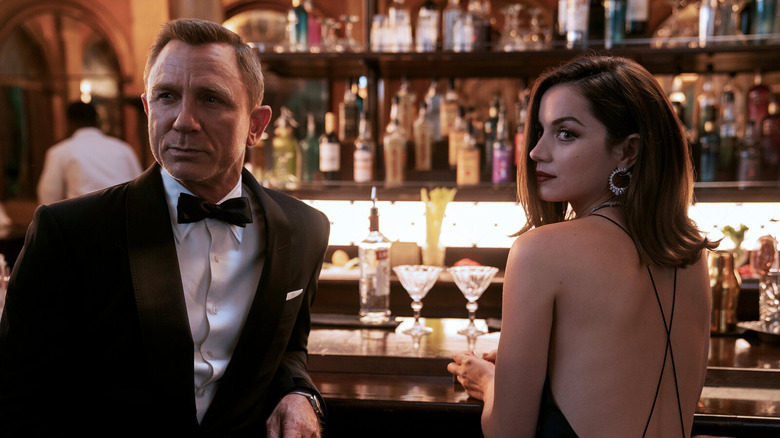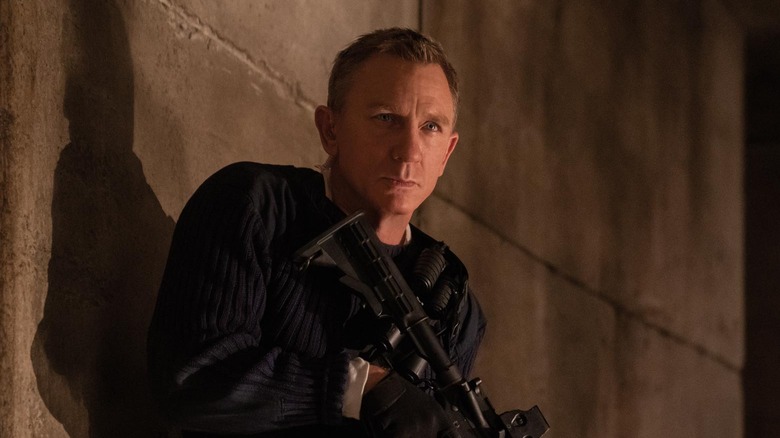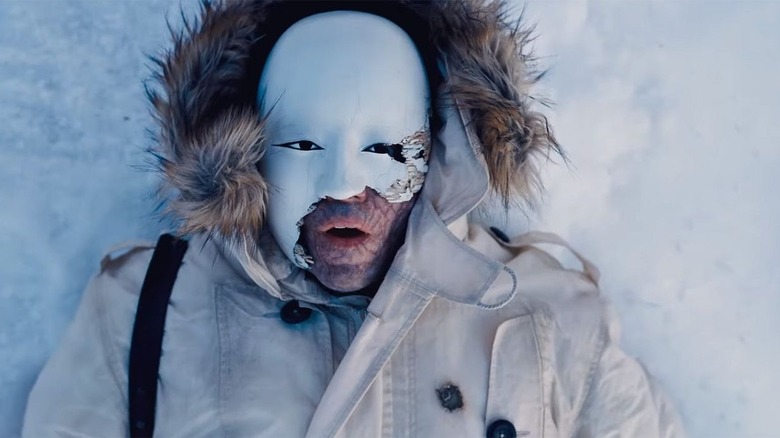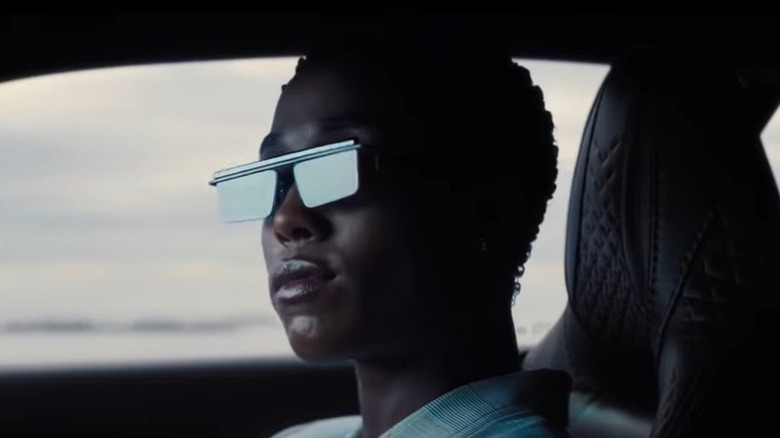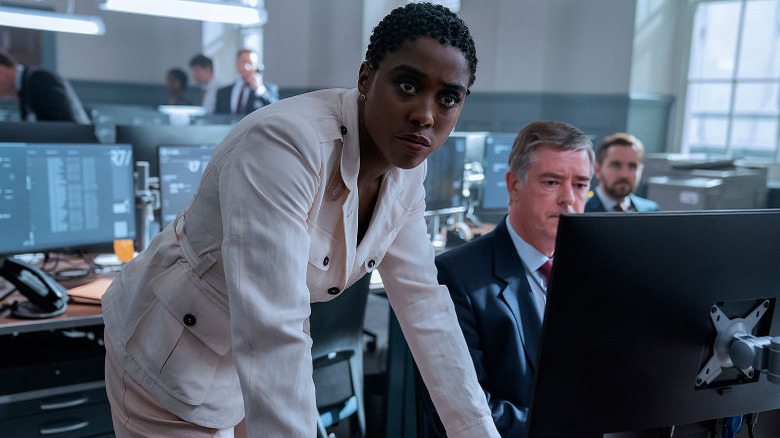No Time To Die Costume Designer Shares How You Dress The Most Stylish Spy In Movie History [Interview]
James Bond may find himself in fantastical situations, but when it comes to style, costume designer Suttirat Anne Larlarb always wanted what felt real for the character. Larlab is known for her collaborations with filmmaker Danny Boyle, including the 2012 opening ceremony of the London Olympics. She was hired for "No Time to Die" when the director was originally attached to the sequel. After his departure, the producers were adamant on keeping her onboard, teaming her with new director Cary Fukunaga.
Ultimately, Larlab struck a balance between the classic and modern Bond aesthetic.
It's all about character, not flash, for the costume designer. The clothes are always an extension of the characters, their emotions, and notably, the locations. The costumes tell a story. Before becoming a costume designer, but after studying at Stanford and Yale University, Larlab worked as an art director and production designer on a variety of films. Now, she's worked on her most ambitious film yet.
Larlab began working on "No Time to Die" over a year before shooting commenced, and recently, she told us about the extensive decision-making that time involved and how you go about dressing the most famous super-spy in all of cinema.
"Something that felt like an iconic silhouette."
You're a big fan of vintage clothing, which you and Daniel Craig discussed quite a bit for the film. What are some vintage pieces in "No Time to Die"?
Throughout all of his wardrobe, I would say there's an element of it. I think the big ticket vintage one is the end, the final costume of his, which is this tactical-looking [costume]. We had discussed wanting to send Daniel's Bond off into film history with something that we haven't necessarily seen him in before, something that felt like an iconic silhouette.
Not a silhouette in the way costume and fashion people talk about the silhouette of a suit, but literally like a silhouette, like the shadow of a figure that you see in that famous iconography of Bond coming through the gun barrel, right? We wanted basically something that would tick those boxes. The sweater that he's wearing at the end, I was hesitating and almost called it a jumper because of course in England, call a sweater the jumper. It's basically an adapted version of a vintage World War II British commando sweater, which I had found and brought to Daniel.
When we were starting to work on what this final look was going to be, I brought that in to show him and he put it on and he loved it. We decided to use that as our jumping off point. There are things that we changed about it, though. The original one still had very period pattern shapes to it, which aren't necessarily as modern as what you are looking at in the film.
So we adapted it for Daniel, changed the color, the material, all that stuff, and collaborated with one of those long-standing brand partners of Bond to have them manufacture it, because we knew we needed something like 48 of them, I believe. We needed lots of multiples of a lot of his costumes and all the numbers are varying between 20 and 60. I think 48 was the number of the sweaters. It becomes an important prop in the film, too. We made it a nod to his Naval heritage, his upbringing in the special services.
We wanted something different. But yeah, there's a drawstring boat neck collar. The original was a very heavy wool, but obviously, for the purposes of our scene and all the action, we are definitely not wanting to have him endure multiple days in the summer shooting this in heavy wool. So, we made it out of a sort of cotton blend.
The trousers were also based on an amalgamation of different vintage combat trousers from Naval origin. The silhouette of a Second World War trouser is not the silhouette that you see on him. They're much higher-waisted, looser-legged. We wanted obviously to have that silhouette idea of him as just, the perfect human form. He has kind of got an Adonis figure. In developing those trousers, it took quite a while. We made the trousers in-house, had an amazing workshop, two tailors and cutters and a bunch of stitchers and people in the dye workshop.
I mean, just the number of hands within the department that each item of clothing passed through, it's an extraordinary amount of work that goes into it. We kept developing the prototype and redeveloping the prototype based on the fact that they were working on the final sequence and all the action and the stunts. Every time Daniel would come in for a fitting, we would do more multiple looks at every fitting, but we would be honing and perfecting various pieces of costumes every time.
And the trousers were one that took a long time to develop over the course of several months because the action in the final sequence was evolving, and he'd come fresh from a stunt rehearsal and be like, oh right, I did the rehearsal today and I know I'm going to pick up the weapon from this angle, and so maybe we should move this pocket over here. We wanted them to feel authentic to what he would need in the scene. It's not just an aesthetic decision or one based on love of vintage clothing, but very much a practical and technical decision.
The franchise usually looks back to the past, but still captures what's modern and new. What were some of the other more modern touches you used?
I think fashion is in this phase where everything goes at the moment. There's also a real love at the moment for vintage. It's a little bit of a catchall. So with each character, I think the approach wasn't necessarily to think, okay, they have a retro style to them, or they have a more contemporary, modern feel to them. It was more character-based. And so with Bond himself, it meant that we could look back because there is this legacy of 24 films and a real evolution between Bond performers in their chapters, as well as the overall evolution of Bond himself as one character.
The freedom to go that way came with characters that were completely new. I think with the returning characters, there was always an obligation to make sure they fit on their evolutionary scale, like you have a lot of returning characters in MI6 headquarters. The new characters like Paloma or Nomi or Rami Malek's Safin, we could just start fresh with them.
"An expressionless gaze."
How did Safin, as a character, influence your choices?
Well, Rami Malek is an amazing actor. I think you wouldn't want to ever suffocate his performance by putting him in something that he couldn't... I'm sure he would never be in the position where he couldn't overcome his costume because he's such a consummate performer. It's playing on that strength where you have somebody who so profoundly embodies a character. A lot of his performance isn't even in the way he delivers a line, it's a look.
It's a glance. It's a physical embodiment and aura that he gives. So, I wanted the costume to compliment those things, be something that was sharp and elegant because Bond villains are always sharp and elegant, but also have a little poetry, a little grace, and not necessarily give away the game that his ambitions are necessarily evil. That part of it needed to come from him.
Therefore, as a mastermind, an incredibly wealthy villain who has access to anything and everything, you don't necessarily want to pinpoint the evil through the costume. It's the costume being an extension of his behavior. He has a very quiet delivery of everything. There's no yelling or screaming. I think the clothes needed to be an extension of that in a way and work with that performance.
I would even say the mask that we developed for him, the first reveal of him in the beginning is also in line with that approach. It's based on a Japanese Noh mask, which fundamentally has an expressionless gaze to it so that the emotion of a performer wearing that mask comes from the performance, lighting, the angle at which you look at the mask. Looking at it from different angles or lighting it different ways, it can run the gamut from serene to evil or angry or pensive or all the things in between.
You have that snowy nightmare in the beginning, but then you get to go to Cuba, Italy, and other countries. How do locations and their history of fashion inspire your work?
I really, really take that to heart, no matter what project I'm doing. I think it's vital when you're setting something somewhere to be truthful to that place. If you're shooting something in America, we know as Americans that America is every flavor under the sun. Every city, every town, every region has its own particularities. And so, when you're talking about the geography of the world and far-flung exotic locations that a Bond film might take you to, you have to respect that, even down to what part of those countries we were in.
We were, for instance, in Matera in Italy in the height of summer, and it's really hot. It's a different place in the winter. It's a different place in the fall. So yes, the climate and the environment definitely play into it. Sometimes, depending on the shots, you want to make sure that it's not just about the environment, the architecture, but you want the living, breathing feel of a place to transport you as the viewer, so that has to be reflected in how the background is dressed.
Sometimes there's a scene, like we have a religious procession in that amazing motorcycle jump. We thought for a long time, well, what is the procession? We needed to give it a purpose. And I'm sorry, it's been so long, I can't remember what that was, but I do remember that we were very specific about what we wanted that procession to be about. Obviously there's a lot of people in black, it's against the stone walls in Matera. A lot of the architecture is carved out of the local stone there. Color is important, and yeah, that all factors in. Definitely pay attention to where we are.
"It is a crazy amount of decision-making."
Nomi's sunglasses, where did those come from?
They are [designer] Adam Selman's x Le Specs [The Flex 1702121]. They were a pair of glasses I found in a boutique in London. It was an amazing pair that I found. Before we even knew what Nomi's exploits were going to be, I brought them into the first fitting. I brought a bunch of glasses and a lot of accessories just to get a feel of things. Lashana went straight to them. I was like, "I'm so happy that you were drawn to them, because we've got to find a place to put them." Then when we knew we had that scene, it would just seem like the perfect way of using them.
They're beautiful. How was your collaboration with Tom Ford?
That is a collaboration that's very long-standing. What happens is we know what we need from the script. We know what we need from conversations with Daniel. And we know that Tom Ford and his team are so well-versed in the language of how to provide costumes for films. They understand the multiples, the time scales we're working on.
Once I knew what we would maybe want in terms of a few day suits and definitely some formal wear, I was able to go to the team and say, "This is what we're after. This one should look a little bit like this. And the evening wear, we know we don't want this." You give them a list of all the things that you're thinking about and some options are presented.
They stuck me in a room and there was this massive table of, I don't know, 15 ginormous books of fabrics swatches. I spent a good couple hours just sifting through everything and picking out the colors and the patterns and the textures that I thought would be appropriate for the scenes that I could imagine. Because they don't get to read the script. It's all held very close to the chest.
So I have in my head, the vision of where things could possibly be. I won't run through the whole technical process of how that gets whittled down into what we end up on screen with, but it is a lengthy process of trying and seeing designs. You pick what you want, you describe all the things you might want to adapt.
There are prototypes made, there are fittings. There's a lot of strategizing about, okay, there's only so much of this fabric left in the world. Is there enough to get the 30-plus suits that we need? The choice of the fabric that we made for his evening wear that he wears in Cuba was so brilliant. When I went for one of the meetings with [Design Studio CEO] David Bamber at Tom Ford, there was a black stretch, silk blend evening wear fabric. I asked if maybe we could look into that, knowing that the stunts he would have to perform, it'd be useful if they were stretch. They were looking to check how much of that was left in the mill in Italy. I went to Daniel and I showed it to him and he was like, "Oh, brilliant, stretch would be great."
Of course, it's not like spandex stretch, but just enough in there to have some room with the amount of physicality involved. Also, you have to make multiples of these suits so that they accommodate the stunt performers and even slightly different sizes for each performer, because some you might use with a harness or various levels of stunt padding.
There are what we would call the beauty suit, which is just walking out there, looking beautiful. It's not the one that necessarily you want to ruin from a stunt. So yeah, there are a lot of moving parts to how you kind of end up with the order that you give to Tom Ford.
I know you said you wouldn't whittle down every detail, but I'd be happy to hear more about the tiniest of nuances that go into that collaboration.
Oh yeah. I actually recently was unpacking my boxes from Bond, and I found the notebook. I had printed out all the emails of my correspondence with Tom Ford's team regarding the tuxedo. It was a three inch binder of emails on all the details. There are a lot of numbers. There's talks of every detail, the width of the shawl collar, from the top of the neck to the bottom, how far over the button is, what kind of button, what kind of cuffs. It is a crazy amount of decision-making.
"We are all very, very nerdy costume historians."
Before you started to work on "No Time to Die," you revisited all the Bond films. Which costumes were very much to your taste or influential? Bond has also maybe had a few fashion missteps, so were there any not to your taste?
I don't know about the missteps because I think they're all, even things that maybe aren't your taste, they lovingly get filed away into, like, "Oh, that's a Bond film." You can get away with it. I would say, I've always loved Bond in the safari suit. That sort of tropical weight wool, multi-pocketed utility jacket, but in the suit form. I purposely recalled that when we see Lashana's Nomi at MI6 headquarters.
When Tom Ford were working with us on Daniel Craig's looks, I asked if I could take a look at what was upcoming in their women's collection. They provided me with all the lookbooks, and there was this women's safari suit in there. I thought that would be amazing, given Lashana's status as the new double O. I thought it would be a nice foil to when she and Bond are walking together and he doesn't have the clearance anymore and she's got all of it.
I was hoping that we could make it work and we did. And so, that's how she ends up in that one. That was one of the immediate go-to's of like, all right, that's in your collection, that is right for this. They very generously provided that for us.
You had a whole year of working on "No Time to Die" before shooting started. What else did that schedule entail for you?
I have four notebooks filled with my to-do lists, and very, very small scale writing on both pages of every spread. It's massive, but it starts with reading the script, breaking it down into its component parts, creating a research list. Every time we get a new draft of the script, recreating the research list. I love leafing through books, magazines, everything physical like that. Not that I don't do research on an image search online, because I absolutely do. Sometimes it's the only way to get a certain image, but also, you type in a few keywords and you know everybody's looking at the same images for the first six pages of the Google image search that you are.
I always want to make sure that the research is authentic, as you said earlier in the conversation, to the regions. We might even go into library histories of a certain little town wherever to get pictures of a certain thing. It's a deep dive research experience and all the assistant designers, Kristin, Ava, and Michael Mooney, the associate [costumer designer], we are all very, very nerdy costume historians.
I think that past the research phase, it's then putting together mood boards, sketches. You start to bring in pieces that you find from the outside that maybe are an inspiration, if not the thing that you want to put in the film. Our department on a normal day was about 50 strong. There are a lot of people to keep busy every day. There are six or seven people working just purely on textile art. Anything from producing residual gunshot wounds to, oh, I wish that blue was slightly more midnight, then Sarah, the textile artist, would provide me with a hundred blues that this shirt that started out as green could go.
It's a massive operation. Like anything you can think of, every kind of artisan, if we didn't have something firm for them to do, we're working on samples for things in the future. We were never twiddling our thumbs. Even when we were waiting for script pages to come, we were always busy. I think because there were 24 other films you could anticipate, what are the kinds of people and scenes that you might end up having? We would try to get ahead of the game. We wanted to uncover things, so we were prepared and ready to shoot from the hip.
